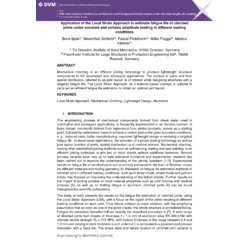- Nur online erhältlich



Joining of materials, either with common or dissimilar mechanical properties or with different sheet thicknesses, is a frequently occurring task in the automotive industry. Mechanical clinching provides several major advantages compared to other joining techniques, such as resistance spot welding or self-piercing riveting, including low energy consumption and potential for lightweight automotive body construction. The totality of the joints, i. e. spatial distribution and number of joints, is referred to as the joint layout. The sheet geometry and the cyclically applied forces govern the loading condition in each joint, resulting in pure shear, pull out or a mixed mode loading.
The material under investigation is the aluminum alloy EN AW-5182, which is widely used in the…

Datenschutzbedingungen (bearbeiten im Modul "Kundenvorteile")

Lieferbedingungen (bearbeiten im Modul "Kundenvorteile")

Rücksendebedingungen (bearbeiten im Modul "Kundenvorteile")
Joining of materials, either with common or dissimilar mechanical properties or with different sheet thicknesses, is a frequently occurring task in the automotive industry. Mechanical clinching provides several major advantages compared to other joining techniques, such as resistance spot welding or self-piercing riveting, including low energy consumption and potential for lightweight automotive body construction. The totality of the joints, i. e. spatial distribution and number of joints, is referred to as the joint layout. The sheet geometry and the cyclically applied forces govern the loading condition in each joint, resulting in pure shear, pull out or a mixed mode loading.
The material under investigation is the aluminum alloy EN AW-5182, which is widely used in the automotive industry, with a sheet thickness of 1.5 mm. The material behavior as input for the process simulation of mechanical clinching is determined in quasi-static tension according to DIN ISO 6892-1 [1]. The cyclic material properties are obtained through constant strain amplitude testing in compliance with SEP 1240 [2]. For a wide range of computationally created clinched joints the fatigue life estimation for different loading conditions, is carried out based on the algorithms described in the German FKM Guideline nonlinear [3] and previously reported in the case of shear loading [4]. The estimated fatigue life up to technical crack initiation is compared to experimentally obtained fatigue life data for different clinched joint geometries and in varying loading conditions. Special attention is paid to clinched joints under variable amplitude loading.
From the extensive numerical investigation of fatigue life up to crack initiation, verified by experimental fatigue testing, conclusions are drown on the applicability of the Local Strain Approach to clinched joints made of aluminum in different loading conditions. Furthermore, an approach is presented to link the geometrical features of the clinched joints, e. g. neck thickness and undercut, to the fatigue life.